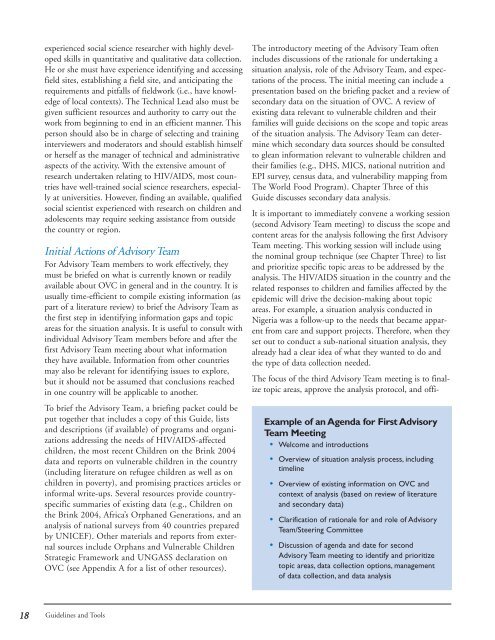Conducting a Participatory Situation Analysis of.pdf - Global HIV ...
Conducting a Participatory Situation Analysis of.pdf - Global HIV ...
Conducting a Participatory Situation Analysis of.pdf - Global HIV ...
You also want an ePaper? Increase the reach of your titles
YUMPU automatically turns print PDFs into web optimized ePapers that Google loves.
experienced social science researcher with highly developed<br />
skills in quantitative and qualitative data collection.<br />
He or she must have experience identifying and accessing<br />
field sites, establishing a field site, and anticipating the<br />
requirements and pitfalls <strong>of</strong> fieldwork (i.e., have knowledge<br />
<strong>of</strong> local contexts). The Technical Lead also must be<br />
given sufficient resources and authority to carry out the<br />
work from beginning to end in an efficient manner. This<br />
person should also be in charge <strong>of</strong> selecting and training<br />
interviewers and moderators and should establish himself<br />
or herself as the manager <strong>of</strong> technical and administrative<br />
aspects <strong>of</strong> the activity. With the extensive amount <strong>of</strong><br />
research undertaken relating to <strong>HIV</strong>/AIDS, most countries<br />
have well-trained social science researchers, especially<br />
at universities. However, finding an available, qualified<br />
social scientist experienced with research on children and<br />
adolescents may require seeking assistance from outside<br />
the country or region.<br />
Initial Actions <strong>of</strong> Advisory Team<br />
For Advisory Team members to work effectively, they<br />
must be briefed on what is currently known or readily<br />
available about OVC in general and in the country. It is<br />
usually time-efficient to compile existing information (as<br />
part <strong>of</strong> a literature review) to brief the Advisory Team as<br />
the first step in identifying information gaps and topic<br />
areas for the situation analysis. It is useful to consult with<br />
individual Advisory Team members before and after the<br />
first Advisory Team meeting about what information<br />
they have available. Information from other countries<br />
may also be relevant for identifying issues to explore,<br />
but it should not be assumed that conclusions reached<br />
in one country will be applicable to another.<br />
To brief the Advisory Team, a briefing packet could be<br />
put together that includes a copy <strong>of</strong> this Guide, lists<br />
and descriptions (if available) <strong>of</strong> programs and organizations<br />
addressing the needs <strong>of</strong> <strong>HIV</strong>/AIDS-affected<br />
children, the most recent Children on the Brink 2004<br />
data and reports on vulnerable children in the country<br />
(including literature on refugee children as well as on<br />
children in poverty), and promising practices articles or<br />
informal write-ups. Several resources provide countryspecific<br />
summaries <strong>of</strong> existing data (e.g., Children on<br />
the Brink 2004, Africa’s Orphaned Generations, and an<br />
analysis <strong>of</strong> national surveys from 40 countries prepared<br />
by UNICEF). Other materials and reports from external<br />
sources include Orphans and Vulnerable Children<br />
Strategic Framework and UNGASS declaration on<br />
OVC (see Appendix A for a list <strong>of</strong> other resources).<br />
The introductory meeting <strong>of</strong> the Advisory Team <strong>of</strong>ten<br />
includes discussions <strong>of</strong> the rationale for undertaking a<br />
situation analysis, role <strong>of</strong> the Advisory Team, and expectations<br />
<strong>of</strong> the process. The initial meeting can include a<br />
presentation based on the briefing packet and a review <strong>of</strong><br />
secondary data on the situation <strong>of</strong> OVC. A review <strong>of</strong><br />
existing data relevant to vulnerable children and their<br />
families will guide decisions on the scope and topic areas<br />
<strong>of</strong> the situation analysis. The Advisory Team can determine<br />
which secondary data sources should be consulted<br />
to glean information relevant to vulnerable children and<br />
their families (e.g., DHS, MICS, national nutrition and<br />
EPI survey, census data, and vulnerability mapping from<br />
The World Food Program). Chapter Three <strong>of</strong> this<br />
Guide discusses secondary data analysis.<br />
It is important to immediately convene a working session<br />
(second Advisory Team meeting) to discuss the scope and<br />
content areas for the analysis following the first Advisory<br />
Team meeting. This working session will include using<br />
the nominal group technique (see Chapter Three) to list<br />
and prioritize specific topic areas to be addressed by the<br />
analysis. The <strong>HIV</strong>/AIDS situation in the country and the<br />
related responses to children and families affected by the<br />
epidemic will drive the decision-making about topic<br />
areas. For example, a situation analysis conducted in<br />
Nigeria was a follow-up to the needs that became apparent<br />
from care and support projects. Therefore, when they<br />
set out to conduct a sub-national situation analysis, they<br />
already had a clear idea <strong>of</strong> what they wanted to do and<br />
the type <strong>of</strong> data collection needed.<br />
The focus <strong>of</strong> the third Advisory Team meeting is to finalize<br />
topic areas, approve the analysis protocol, and <strong>of</strong>fi-<br />
Example <strong>of</strong> an Agenda for First Advisory<br />
Team Meeting<br />
• Welcome and introductions<br />
• Overview <strong>of</strong> situation analysis process, including<br />
timeline<br />
• Overview <strong>of</strong> existing information on OVC and<br />
context <strong>of</strong> analysis (based on review <strong>of</strong> literature<br />
and secondary data)<br />
• Clarification <strong>of</strong> rationale for and role <strong>of</strong> Advisory<br />
Team/Steering Committee<br />
• Discussion <strong>of</strong> agenda and date for second<br />
Advisory Team meeting to identify and prioritize<br />
topic areas, data collection options, management<br />
<strong>of</strong> data collection, and data analysis<br />
18<br />
Guidelines and Tools















